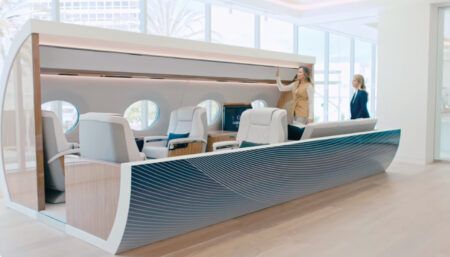Fabian Nagel, VP of sales for VIP & Special Aircraft Services at Lufthansa Technik, discusses the potential of wall projection technology, increasing interest in onboard health and fitness, 3D modelling and more.
What material and technological developments interest you?
Inspired by the automotive industry, we aim to offer an even wider range of eco-friendly materials in the future. These include vegan or recycled leather; lacquer or print film technologies as substitutes for wood veneers; and engineered stone or faux-finish options as alternatives to marble.
Besides the usual advancements/enlargements of conventional screen technology, we are testing smart surfaces that react to touch, enabling intuitive control of the IFE. Another highlight is the further development of large-scale wall projections – as demonstrated in our CelestialStar concept – that provide immersive visual effects.
With Omni-Fi, our speaker system that can be seamlessly integrated into the aircraft ceiling, we are also bringing top-tier audio quality into the cabin.
We also aspire to offer an even smarter concept: surfaces that adapt on demand; increased resistance to dust and scratches; and intuitive control via voice or gesture commands.
What trends do you see for the year ahead?
We see rocketing demand for LEO satellite connectivity. With much smaller and electronically steered antennas, LEO will enable a more seamless IFEC experience, from high-res video-streaming and cloud-based services to HD gaming.
We also witness ever-increasing interest in onboard fitness, health and medical equipment. Our Patient Transport Unit Next Generation (PTU NG) is in high demand, not only for head-of-state aircraft or with armed forces, but also in private aircraft, often along with equipment such as a treadmill or exercise bike.
Are new design/visualisation technologies impacting you?
We are now able to create our designs directly as 3D models. This allows us to identify potential weaknesses at an early stage, and also improves collaboration between designers and engineers – particularly when assessing the feasibility of complex furniture and seating designs, and in regards to rapid prototyping through 3D printing.
Customers expect concepts to be presented as high-resolution renderings in the very first meetings, with material and lighting concepts included. Our designs can also be presented using VR. However, while some find navigation in virtual space intuitive, others prefer us to present 3D design models on a computer.
AI is having an increasing impact on our daily design work. We’re still in an experimental phase and have observed it provides only limited support in this highly specialised field. However, it assists in the early design stages by generating mood images or visualising furniture design variations.
Do you have ideas for eVTOLs?
We can imagine extending our ‘nice’ IFE system portfolio to eVTOL cabin applications. The Modular Pax unit, an initial concept shown at EBACE 2024, gave a first glimpse of what a ‘nice’ contribution to the AAM world could look and feel like. Its single base can be tailored with various elements. With interchangeable cabin control features such as gaspers, buttons and connectors, this cabin interface would first enable customisation and later easy swapping and maintenance of single modules and functionalities.
This interview was conducted by Izzy Kington and first published in the March/April 2025 edition of Business Jet Interiors International as part of the Design Forum feature.





